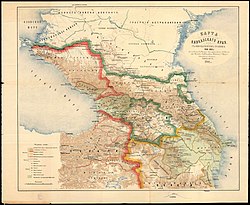| The Sultanate of Borchaly | |||||||||
|---|---|---|---|---|---|---|---|---|---|
| 1604–1801 | |||||||||
 Map of countries in the Caucasus including Borchaly sultanate in 1801 Map of countries in the Caucasus including Borchaly sultanate in 1801 | |||||||||
| Status | sultanate | ||||||||
| Common languages | Persian, Azerbaijani, Armenian, Georgian | ||||||||
| Religion | Islam | ||||||||
| Government | Absolute monarchy | ||||||||
| History | |||||||||
| • Established | 1604 | ||||||||
| • Disestablished | 1801 | ||||||||
| Area | |||||||||
| • Total | 6,528 km (2,520 sq mi) | ||||||||
| |||||||||
Borchaly sultanate (also known as Borchaly khanate) — was a feudal state that existed until the middle of the XVIII century on the territory of the historical region of Borchaly (modern day Georgia and the Lori region of Armenia).
History
According to "Georgian Soviet Encyclopedia", at the beginning of the XVII century, during the rule of Shah Abbas I, the Turkic tribe Borchalu migrated to Debed Valley, which gave its name to the region Borchaly. In 1604 the Borchaly khanate (sultanate) was established here. In the 1750s, Tsar Kartli Teymuraz II took over the Sultanate of Borchaly, and in 1765 the tsar of Kartli-Kakheti Irakli II transformed the sultanate into a prefecture. By the beginning of the 19th century, the sultanate was completely dissolved and became part of the Russian Empire.
Rulers
- Musa Kuli-khan, son of Kelbi Huseyn-khan (1752–1755)
See also
- Kazakh sultanate
- Shamshadil sultanate
- Shoragel sultanate
- Khanates of the Caucasus
- South Caucasus
- Azerbaijan Democratic Republic
References
- ^ Ketevan Nadiradze (2012). "Explanations to geographical names". Caucasus in georgian sources: Foreign States, Tribes, Historical Figures. Encyclopedical Dictionary. Tbilisi: Favorite. p. 382. ISBN 978-9941-0-3946-1.
- "«Грузинская советская энциклопедия», ст. «Борчало». Тбилиси, 1965".
- Tamar Koridze (2012). "MUSA-KULI KHAN // MUSAKHAN". Caucasus in georgian sources: Foreign States, Tribes, Historical Figures. Encyclopedical Dictionary. Tbilisi: Favorite. p. 331. ISBN 978-9941-0-3946-1.